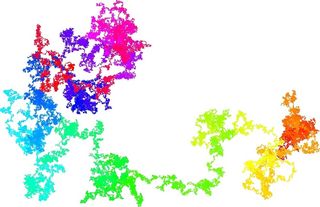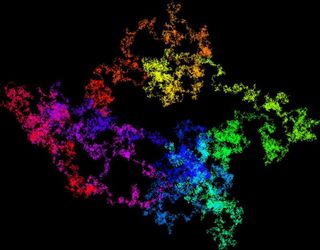
We Still Can't Get Enough Pi ... But Why? (Op-Ed)

This article was originally published at The Conversation. The publication contributed the article to Live Science's Expert Voices: Op-Ed & Insights.
The number pi (π = 3.14159265358979323846…), unique among the pantheon of mathematical constants, captures the fascination of the public and professional mathematicians. Three years ago one of the authors wrote about pi on The Conversation and the number’s popularity hasn’t diminished in the meantime – in fact, quite the opposite.
Algebraic constants, such as √2, are easier to explain and calculate to high accuracy. Euler’s number (e = 2.71828…) is pervasive in physics and chemistry, and even appears in financial mathematics. Logarithms are ubiquitous in the social sciences.
But none of these other constants has ever gained much traction in the popular culture – and it is arguably the only mathematical topic from very early history that is still being researched today:
- the Babylonians used the approximation pi ≈ 3
- the Egyptian Rhind Papyrus, dated roughly 1650BCE, suggests pi = 32/18 = 3.16049…
- early Indian mathematicians believed pi = √10 = 3.162277…
- Greek mathematician and philosopher Archimedes, in the first mathematically rigorous calculation of pi, employed a clever iterative construction of inscribed and circumscribed polygons to able to establish that 3 < 10/71 = 3.14084… < pi < 3 1/7 = 3.14285…
Pi in popular culture

In an early scene of Ang Lee’s 2012 movie adaptation of Yann Martel’s award-winning book The Life of Pi, the title character Piscine Molitor “Pi” Patel writes hundreds of digits of the decimal expansion of pi on a blackboard to impress his teachers and schoolmates, who chant along with every digit. (Good scholarship requires us to say that in the book Pi contents himself with drawing a circle of unit diameter.)
This has even led to humorous take-offs such as a 2013 Scott Hilburn cartoon entitled “Wife of Pi”, which depicts a “4” figure seated next to a pi figure, telling their marriage counsellor: “He’s irrational and he goes on and on."
This attention comes to a head each year with the celebration of “Pi Day” on March 14, when, in the US with its taste for placing the day after the month, 3/14 corresponds to the best-known decimal approximation of pi (with 3/14/15 promising a gala event next year).
Sign up for the Live Science daily newsletter now
Get the world’s most fascinating discoveries delivered straight to your inbox.
Pi Day was originally founded in 1988, the brainchild of Larry Shaw of San Francisco’s Exploratorium (a science museum), which in turn was founded by Frank Oppenheimer, the younger physicist brother of Robert Oppenheimer, after he was blacklisted by the US government during the McCarthy era.
Originally a light-hearted gag where folks walked around the Exploratorium in funny hats with pies and the like, by the turn of the century Pi Day was a major educational event in North American schools, garnering plenty of press.
In 2009, the US House of Representatives made Pi Day celebrations official by passing a resolution designating March 14 as “National Pi Day,” and encouraging
schools and educators to observe the day with appropriate activities that teach students about Pi and engage them about the study of mathematics.
This seems to be the first legislation on pi to have been adopted by a government, though in the late 19th century Indiana came embarrassingly close to legislating its value (see the video below).
How pi was nearly 3.2.
As a striking example, the March 14, 2007 New York Times crossword puzzle featured clues, where, in numerous locations, a pi character (standing for “PI”) must be entered at the intersection of two words.
For example, 33 across “Vice president after Hubert” (answer: SPIRO) intersects with 34 down “Stove feature” (answer: PILOT). Indeed 28 down, with clue “March 14, to mathematicians,” was, appropriately enough, PIDAY, while PIPPIN is now a four-letter word (πPπN).
Pi mania
There are many more instances of pi in popular culture. Here are just a few:

- on September 12, 2012, five aircraft armed with dot-matrix-style skywriting technology wrote 1,000 digits of pi in the sky above the San Francisco Bay Area as a spectacular and costly piece of “piformance” art
- on March 14, 2012, US District Court Judge Michael H Simon dismissed a copyright infringement suit relating to the lyrics of a song by ruling that “Pi is a non-copyrightable fact”
- on August 18, 2005, Google offered 14,159,265 “new slices of rich technology” in their initial public stock offering. On January 29, 2013 they offered a pi-million dollar prize for successful hacking of the Chrome operating system on a specific Android phone
- in the first Matrix movie, lead character Neo has only 314 seconds to enter the Source
- the 1998 thriller Pi received an award for screenplay at the Sundance film festival. When we were sent advance access to its website, we misdiagnosed it a fine hoax – a bogus website is much cheaper than an improbable Hollywood movie!
- the May 6, 1993 edition of The Simpsons had Apu declaring “I can recite pi to 40,000 places. The last digit is 1” (This digit was supplied to the screen writers by one of the present authors.)
- in Carl Sagan’s 1986 book Contact, the lead character (played by Jodie Foster in the movie) searched for patterns in the digits of pi, and after her mysterious experience sought confirmation in the base-11 digits of pi
- on the September 20, 2005 edition of the North American TV quiz show Jeopardy!, in the category “By the numbers,” the clue was “‘How I want a drink, alcoholic of course’ is often used to memorise this”. (Answer: “What is pi?” because the number of letters of these words spells the digits of pi.)
With regards to the final item above, there are many such “pi-mnemonics” or “piems” (phrases or verse whose letter count, ignoring punctuation, gives the digits of pi) in the popular press.
Another is
Sir, I bear a rhyme excelling / In mystic force and magic spelling / Celestial sprites elucidate / All my own striving can’t relate.
Sometimes the attention given to pi is annoying. On 14 August 2012, the US Census Office announced the population of the country had passed exactly 314,159,265. Such precision was, of course, completely unwarranted. But sometimes the attention is breathtakingly pleasurable.
Poems versus piems
Here are some examples of excellent pi poetry and song. Below we present the first stanza of the much anthologised poem “Pi” by Polish poet Wisława Szymborska (1923-2012), who won the 1996 Nobel prize for literature, from her published collection.
The admirable number pi: / three point one four one. / All the following digits are also initial, / five nine two because it never ends. / It can’t be comprehended six five three five at a glance, / eight nine by calculation …
Below we present the beginning of the lyrics of “Pi” by the influential British singer songwriter Kate Bush – and an appropriate closing example for this article. The Observer review of her 2005 collection Aerial, on which the song appears, wrote that it is
a sentimental ode to a mathematician, audacious in both subject matter and treatment. The chorus is the number sung to many, many decimal places.
(She sings more than 150 digits but errs after 50 places. The correct digits are given in the published lyrics.)
Sweet and gentle sensitive man With an obsessive nature and deep fascination For numbers And a complete infatuation with the calculation Of Pi.
Our slice of pi
A fruitful new approach is to display the digits of pi or other constants graphically, cast as a random walk.
The first plot below shows a walk based on one million base-4 pseudorandom digits generated by a computer, where at each step the graph moves one unit east, north, west or south, depending on the whether the pseudorandom base-4 digit at that position is 0, 1, 2 or 3.
The colour indicates the path followed by the walk, coloured by a standard hue-saturation-value scheme that produces a rainbow of colours.

The next figure shows a walk on the first 100 billion base-4 digits of pi. This may be viewed dynamically in more detail online at the Gigapan site, where the full-sized image has a resolution of 372,224 x 290,218 pixels (108.03 billion pixels in total).
This is one of the largest mathematical images ever produced and, needless to say, its production was by no means easy (see this paper for technical details).

The best is yet to come
Such techniques are used to study what is arguably one of the oldest unanswered questions of mathematics: are the digits of pi “random”? (say in the specific sense that each decimal digit occurs, in the limit, 1/10 of the time, each pair of digits occurs 1/100 of the time, and so on).
Sadly, we still don’t know the answer to this age-old question (and many others). But with the advent of modern computer technology, maybe the balance is finally tipping in favor of mathematicians (see this technical paper by the authors, from which the above article is condensed and adapted (with permission of the American Mathematical Monthly) for details).
In any case next year is 2015 and so Pi Day will be the most accurate ever: 3/14/15.
A version of this article first appeared on Math Drudge.
Jonathan Borwein (Jon) receives funding from ARC.
David H. Bailey does not work for, consult to, own shares in or receive funding from any company or organisation that would benefit from this article, and has no relevant affiliations.
This article was originally published on The Conversation. Read the original article. The views expressed are those of the author and do not necessarily reflect the views of the publisher. This version of the article was originally published on Live Science.












